Biophilic pods beat the shade when it comes to outdoor cooling
Oscillating fans and sun umbrellas aren’t effective for cooling in hot and humid climates. Considering that, CallisonRTKL is developing Xylem, a self-sustained outdoor cooling system that can lower temperatures roughly 9°F when compared to shaded areas.
The martini-glass-shaped pods have a canopy with PV panels and a green roof, which blocks the sun and cools the air above through evaporation. The stem allows natural air movement and radiant cooling, as air emanates from both the insulated stem and the porous ceramic flooring.
The project’s genesis comes from “xylem,” the transport tissue in plants that moves water from roots to shoots and leaves. For the pods, cooled water circulates from the base through its structural core and conductive cladding.
“It works like a tree, but in many ways, it augments the qualities of a tree,” says Pablo La Roche, an Associate VP with CallisonRTKL and Xylem’s creator.
A single Xylem pod will provide comfort for individuals, but clustering them will be more effective. A strategy involving multiple Xylems and trees, green roofs, cool roofs, and cool pavements will reduce sun-exposed pavement and lessen the effects of a heat island.
“If we had many of these Xylems, combined with all sorts of different strategies, you can reduce the temperature of the air around the city by maybe 1.5°F to 2°F,” says La Roche.
The pods come in heights between 11 and 23 feet and are suited for markets, playgrounds, beaches, and other community spaces.
The first Xylem prototype will be tested at the end of August in Jakarta, Indonesia.
